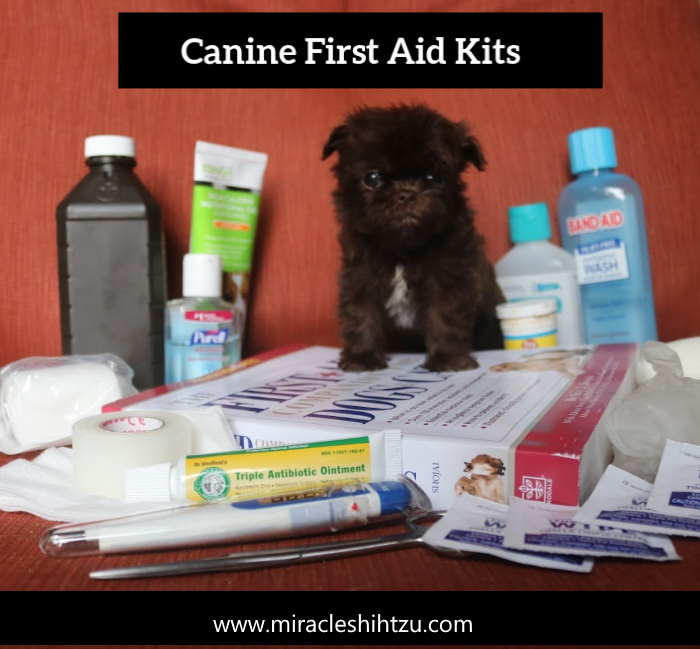Your Shih Tzu Dog First Aid Kit
By Janice Jones Last Updated 11-25-2023
Do you need a dog first aid kit? If you own a dog, then the answer is a resounding Yes. Things happen, often through no fault of your own and you want to be prepared for any emergency.
A fully stocked first aid kit will help put your mind at ease knowing that you can handle minor as well as major emergencies.
 My Shih Tzu Dogs' First Aid Kit
My Shih Tzu Dogs' First Aid KitAdding a few basic medications also helps keep you prepared for minor medical issues that are sure to arise from time to time.
Luckily, stocking a canine first aid kit for your canine child is much the same as stocking a first aid kit for yourself with a few exceptions. It does not need to be fancy or costly and can be something you can put together from items that you may already have in your home.
The key to a well-stocked canine first aid kit is that it will be easily available and well organized so you will not spend valuable time searching for the needed item. Having a complete first aid kit at home is the first step, but you may want to consider where and how the dog travels.
If you take your dog on car rides, a smaller version of the kit should be kept in your car. Do you walk your dog? Chances are that you might appreciate having a portable kit that fits into a backpack or purse even if the walk is short.
Your Options for a Dog First Aid Kit
There are two options for first aid kits for dogs.
Purchase a Ready-Made Kit
The first and easiest is to purchase a kit from the store or internet and then add items if needed. This is the easiest and possibly less costly than assembling your own. There are definite pros and cons to this method for acquiring a standard ready-made first aid kit.
Pros
- A commercially available first aid kit contains everything you need for most emergency situations
- There is no need to shop for each item individually
- Most come with a first aid card or small booklet of information
- All come its own carrying case, pouch, or container
- Most are reasonably priced
- Some are designed to work well for cats and humans as well as dogs so no need for separate kits
- Good choice if you have one or two dogs
Cons
- Varies in price: the more expensive, the more comprehensive assortment of supplies (but don't be deceived by the number of items advertised: some kits that are intended for people and dogs will be filled with band aids making them seem like a good deal but useless for dogs)
- Most supplies come in small individual packets that will need to be replaced when gone
- Supplies/equipment such as tweezers, scissors, thermometers may be of low quality
- Once size fits all may not work for all dogs
- Many are designed for one or two emergencies and then need to be refiled with supplies (for example, one pair of disposable gloves, four gauze pads, one instant cold pack and four alcohol swabs won't go far in a real emergency.
- May not work if you have more than one dog
Assemble Your Own Kit
The second option is to start from scratch, purchasing items from a store. To make your own, you will need a suitable container to keep all your supplies organized and neat.
A small toolbox works well as well as a fishing tackle box. You can
also use a cardboard box or a plastic tote. If you decide to use a
cardboard box, you might want to line it or cover it in contact paper to
help it last longer. Since you will be adding liquid items such as
hydrogen peroxide that can spill, you will want to make sure that your
container can be easily cleaned.
The key is to find something
that is easy to grab and move. If you keep all your supplies in a
kitchen drawer, for example, they will not be as portable and you will
be finding yourself grabbing items, one at a time. To keep the canine
first aid kit organized.
I like to place like items in small sandwich or snack bags. An entire travel first aid kit for walks or car rides fit nicely in a gallon size bags that you can reseal. Keep one of these in your car for emergencies, canine or human and another one by the door for your daily walks.
Stocking Your Dog First Aid Kit
The contents of your kit should include traditional first aid supplies as well as items that you will use for medical problems such as the occasional bout of diarrhea.
The following items should be a part of any first aid kit, both travel as well as home.
Basic First Aid Supplies for your Dog First Aid Kit
- Cotton balls for applying antiseptic solutions to cuts and wiping debris from eyes
- Gauze pads of different sizes to help stop bleeding and to use when applying a bandage over a wound
- Adhesive tape as well as self-stick bandage material such as Vet wraps to apply over wound dressings. Vetwrap is stretchy and sticks to itself. Do not wrap too tightly
- Roll gauze to make a temporary muzzle if needed or a purchased muzzle. Even the sweetest dogs can become aggressive if hurt.
- Antiseptic solution (such as hydrogen peroxide, betadine skin cleaner to clean wounds)
- Hydrogen peroxide (3%) can also be used to induce vomiting and clean blood from a wound or clean blood off of your clothing . Always contact your veterinarian or local poison control center before inducing vomiting or treating an animal for poison
- Sterile saline contact lens solution to flush wounds and eyes
- Scissors for cutting tape, bandages and for removing hair around the injured area
- Tweezers or hemostat for removing ticks, thorns or other foreign objects
- Flashlight to help see clearly
- Magnifying glass, if cut or injury is small
- Cold pack
- Sterile gloves to protect yourself and the dog
- Plastic wrap such as Saran Wrap) to help seal wounds
- Bubble wrap to splint broken limbs
- Rectal thermometer
- Lubricant such as petroleum jelly to lubricate rectal thermometer
- First Aid guide
Additional Medications & Supplies to keep on Hand
- Buffered aspirin for pain (or ask your vet for a small supply of vet recommended pain relievers)
- Antibiotic ointment (Neosporin)
- Antihistamine (Children's Benadryl or
- Hydrocortisone cream to reduce itching
- Antidiarrheal (Kaopectate)
- Styptic powder (Kwik Stop for minor bleeding)
- Immdium A-D can be used to treat diarrhea. Check with your vet for dosage for your dog. Do not use until you have determined the reason for the diarrhea.
- Syringe or eyedropper to help administer liquid medicine
- Heating Pad with a non-shut off control
- Blankets or Towels large enough to wrap or cover your pet or use as a stretcher
- Small towels to help stop bleeding if profuse
- Bathroom scale to keep accurate weights on your dog
Important Telephone Numbers
- Telephone Numbers: Your Veterinary Clinic
- Telephone Numbers: Emergency Vet Hospital in Your area
- Telephone Number: Animal Poison Control Center:
- 888-4ANI-HELP (888-426-4435) There may be a fee for this call
Additional Supplies for a Portable Kit
- Bottled water, collapsible dog bowl for travel kits
- Extra slip collar leash
- Pet waste bag
- Small blanket
- High calorie source such as Nutri-cal or Karo Syrup to treat Hypoglycemia
Top Priorities When Offering First Aid For Your Shih Tzu
What emergency people might call triage, you can learn to prioritize your dog's injuries in the order from most severe to least. But before you try to do anything, be sure you and your dog are in a safe place. This may mean moving your dog from the middle of the road or applying a muzzle for your own protection. Remember you won't be able to help your dog if you are injured.
According to Amy D. Shojai, in the First Aid Companion for Dogs and Cats,
Priorities from most severe to least
- No Breathing ~ No Pulse
- No Breathing ~ With a Pulse
- Loss of Consciousness
- Shock (Pale gums, rapid breathing, weak pulse, cold to touch)
- Difficult breathing
- Chest Puncture or gaping wound
- Severe bleeding
- Abdominal puncture or gaping wound
- Extreme body temperature
- Poisoning
Final Thoughts
Many people think of an emergency as something obvious such as bleeding, non responsiveness, labored breathing, but your dog may need immediate care. Always call your vet first before attempting to do any first aid if at all possible. First aid should be thought of as a one time reaction on your part before professional help can be obtained.
"Hi, I'm Janice Jones, a former veterinary technician and Shih Tzu expert with over 40 years of experience with the breed. Through Miracle Shih Tzu, I combine my medical background and extensive breed knowledge to provide reliable, practical advice for Shih Tzu owners. My mission is to help you give your Shih Tzu the happiest, healthiest life possible through evidence-based information and real-world solutions. Whether you're new to the breed or a seasoned owner, you'll find trusted guidance here for all aspects of Shih Tzu care.
I hold an undergraduate degree in Psychology with a minor in biology, Early Childhood Education, and Nursing, and a Master's in Mental Health Counseling.



